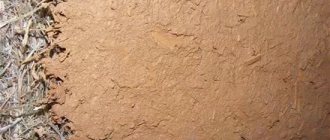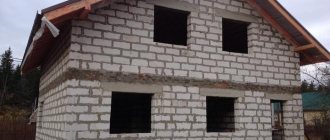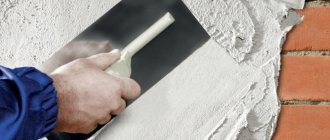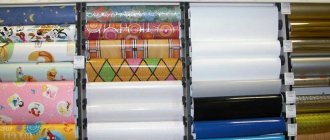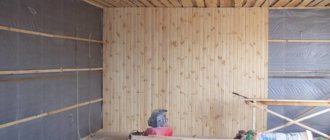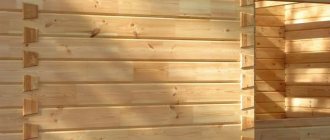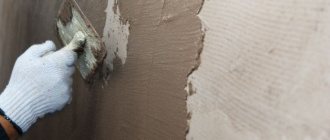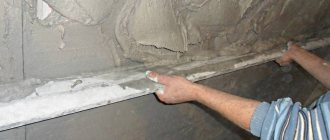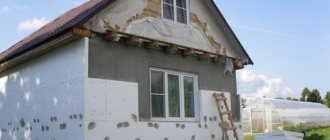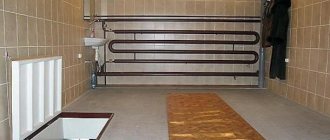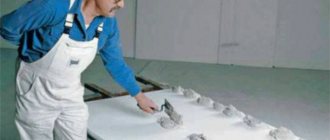Foam block is one of the most popular building materials today. In addition to high performance characteristics, it is characterized by relatively low cost and ease of processing. The only “but” is the need for finishing it, both internal and external. Therefore, plastering of foam block walls will be required. Let’s take a closer look at how to carry it out correctly.
Why plaster foam blocks inside the house
Building structures made of foam blocks require finishing. Plaster is used to seal the seams between the elements, give a smooth surface to which wallpaper is glued, decorative plaster or paint is applied.
Plastering improves the performance of products:
- improves thermal insulation properties;
- protects against temperature changes;
- prevents moisture absorption.
Foam blocks are cellular concrete, which easily absorb water and cause dampness in the room. This is especially true in areas with a humid climate.
Exterior view of an unplastered wall Source postroystenu.ru
Conclusion
To plaster walls made of foam blocks, it is necessary to use only permeable materials that can reliably protect the walls from the effects of negative factors both outside and inside the room.
If everything is done efficiently and in accordance with the developed technologies, then you will only have to occasionally seal small cracks and periodically restore the color of the paint.
Preliminary preparation of walls
Walls made of foam blocks do not need leveling, as they form a smooth surface. However, such a structure has poor adhesion to the subsequent finishing coating. To increase the absorbent effect, use the following solutions:
- Cover the walls with special primers or concrete-contact composition. These building mixtures penetrate the body of the foam block, some of them form a surface rough layer that provides adhesion to the plaster.
- Fastening the reinforcing element. Usually these are meshes made of metal or polymer materials, secured to the block with nails, glue, or dowels. The reinforcing element helps to bond the plaster to the surface of the foam block walls.
Experienced builders recommend using polymer mesh; this solves two problems - they eliminate the appearance of rust stains on the walls due to the formation of metal corrosion, and the ability to save money, since polymer meshes are cheaper.
Surface preparation Source sakh.com
Preparation for work
Be sure to prepare the base before plastering the foam block wall. The preparatory stage is as important as the plastering process. If the walls are not properly treated, the applied layer will not last long and the owner will have wasted his time and money.
Therefore they do the following:
- Remove the mortar that protrudes from under the blocks or the old decorative cladding.
- Remove all fasteners or hanging structures.
- If there are cracks or depressions, they are sealed with rough mortar.
- Clean the surface from dust, dirt and mold.
- Apply primer.
How to prime walls correctly?
Priming walls has its own characteristics, which both novice builders and experienced craftsmen need to know about. Since the foam block has a smooth surface, the plaster solution does not adhere well to it. The primer will create a base on which the mixture will lie smoothly and reliably.
Therefore, they cover the facade walls with a primer solution 3 times:
- 1 layer penetrates into the thickness of the material;
- 2 layer forms a suitable surface;
- The 3rd layer provides a connection between the plaster mortar and the bottom layer.
Each subsequent layer is applied only after the previous one has completely dried. You can start plastering only when all layers are dry.
Attention! Do not buy a cheap option, it is better to spend a little more and be confident in the reliability of the work performed.
How to plaster wall blocks inside a house
When choosing what to plaster foam blocks with, you should remember that you cannot use building mixtures intended for other building structures. The plaster needs to be light and should have maximum adhesion.
The following brands of this type are offered on the market:
- “Win” series, Egida TM-35 brand. Designed for working with foam concrete inside and outside the building.
- "Decor" Ш-36. The composition uses cement with elements of synthetic fiber, which is a reinforcing link. The plaster is easy to apply by hand and adheres well to foam concrete.
- Ceresit CT24. It has been used for a long time and successfully due to its excellent qualities and low price.
- Glims Velur. Perlite plaster mixture for finishing surfaces made of cellular concrete, fits well, does not crack over time, applied in 2-3 layers.
Products from manufacturers EuroMix, Ceresit, Belgips Best plaster, PROFIT Contact MN are widely used. They are characterized by high adhesion, ensuring reliable adhesion of foam concrete and plaster. Used for work outside and inside the building.
Plaster mixtures for foam blocks are sold ready-to-use or in the form of a dry powder Source stroy-gazobeton.ru
See also: Popular designs for bathhouses made of foam concrete blocks.
Nuances of plaster
The foam block has one feature: if the house is new, you need to plaster both sides of the wall at once, and not live in the house for 2-3 weeks after the work has been completed. If it is not possible to carry out finishing at the same time, then it starts from the inside, then excess moisture will evaporate outside. Plastering can be done in parallel both outside the building and inside residential premises.
When choosing a mixture, you need to pay attention to its vapor barrier characteristics, which should be close to foam concrete. Manufacturers often indicate on the packaging of the material which walls it is intended for plastering. It is better to choose soil for finely porous bases, which is intended for concrete surfaces.
Plastering should be carried out no earlier than 30 days after the construction of the building frame
Rules for plastering foam blocks
To explain how to plaster a wall made of foam blocks with your own hands, let’s focus on the important nuances of the process:
- it is necessary to observe the temperature regime, plastering is performed when the outside air temperature reaches +5 degrees, its maximum value is +30 °C;
- when using polymer mixtures, it is allowed to reduce the thickness of the layer, while taking into account the requirements of the instructions for the material;
- as a finishing coating it is permissible to apply plaster with the addition of dye to it; it is possible to purchase ready-made multi-colored mixtures;
- Galvanized mesh is used as a reinforcing element to prevent the appearance of rusty stains on plastered walls.
Between finishing stages it is important to observe the breaks required by the technological processes. Leave each layer until completely dry before applying the next one.
Plastering walls using beacons Source harthaus.ru
Possible problems
Based on the experience of using plasters, it is possible to determine the main possible problems and possible causes.
- Poor adhesion of the plaster mixture. When using a mixture of sand and cement prepared by yourself, ensuring the quality of plastering is difficult. This coating may simply fall off. Possible defects are prevented by using special construction solutions: concrete contacts or primer paints. It is important to carry out the work using reinforced plaster mesh.
- Manifestation of rust. Metal reinforcing mesh may rust. You need to choose galvanized mesh and fiberglass mesh.
- Low strength and slow hardening of plaster. This can be avoided by observing the temperature regime for work, which represents a range from 5 to 25 degrees Celsius.
- Peeling plaster. There is an opinion that when applying a primer, the surface does not absorb moisture well. To avoid this problem, it is necessary to select the right primers that improve adhesion and block efflorescence. Cinder block 3-4 years from the date of manufacture, during the evaporation of water, removes salts, which over time destroy the plaster.
- Irregularities when applying plaster. It is necessary to follow the rule of pouring the plaster mixture into the water, and not vice versa. Do not pour water into dry powder. When mixing the mixture, you should first pour less water than indicated in the instructions, then add water little by little to achieve the required consistency.
At the production stage, foam blocks are coated with a hydrophobic solution. You should not erase this layer, as some may recommend. This solution can provoke dampness inside the building.
Indoor plastering technology
Let's consider the process of how to properly plaster walls made of foam blocks indoors. Perform the following types of work:
- Clean block walls from dirt and rust stains.
- Degrease the surface with solutions, such as a soda solution or a sewer pipe cleaner diluted with water.
- Apply the primer with a sprayer, brush, or roller. The work is carried out in 2-3 stages, waiting for the previous layer of soil to dry. This number of layers is required to impregnate the surface of the foam block and provide better adhesion to the plaster.
- Fix the reinforcing mesh. For the metal version, dowels are used. The plastic mesh is fixed using a solution or special glue. For walls inside the building and partitions, fiberglass material with a small cell, which is glued to the surface of the foam block, is suitable.
- When applying a thick layer of plaster, beacons are installed to obtain a flat surface.
- The solution is spread onto the surface with a trowel and leveled.
- After the plaster has dried, the walls are re-leveled, sagging and excess mortar are removed.
Laying reinforcing mesh Source yandex.net
See also: Catalog of companies that specialize in finishing materials.
When plastering internal walls made of foam blocks, a layer thickness of 10 mm is sufficient. After it has completely dried (the time is indicated in the instructions for using the mixture), a primer is applied, then the surface is finished.
Which primer to choose for foam blocks under plaster
Adhesion is what is important to achieve when plastering surfaces, since the structure of the blocks is smooth. This can be done in two ways:
- Primer.
- Reinforcing mesh.
The mesh not only improves adhesion, but prevents cracking of the layer and strengthens it. As for the primer, it creates an ideal surface for plastering. A thin film is formed, filling all the pores. As a result, adhesion improves and plaster consumption is reduced.
The primer for foam blocks under plaster must meet certain requirements. When choosing, take into account the humidity in the room, the roughness of the wall, and future finishing. Acrylic primers are usually chosen for this purpose. The best manufacturers are: Prospectors, Ivsil – Basis-beton, Volma-Plast, Knauf Grundiermittel, Siltek E-110.
Technology for plastering external walls made of foam blocks
The need to finish the surface of structures made of cellular concrete was mentioned earlier; then we will consider how to properly plaster foam block walls on the outside of a building. The outer walls of the building are exposed to precipitation, dust particles and gases from the surrounding air, and temperature differences between seasons. The negative influence of the environment leads to the destruction of blocks, loss of appearance, and moisture penetration into the walls.
Vapor-permeable materials are used for finishing external walls. The same compositions as for interior plaster are suitable; some mixtures are universal. The following work is carried out step by step:
- cleaning and degreasing the surface of blocks;
- applying a primer;
- laying reinforcing mesh;
- plastering;
- finishing.
Determining the evenness of walls and plaster Source vse-otoplenie.ru
Why do you need to plaster foam concrete blocks?
Plastering walls made of foam blocks, as well as plastering walls made of gas silicate blocks and other porous materials, allows you to solve many problems:
- protect walls made of foam concrete blocks from temperature changes, moisture condensation and the formation of dampness;
- provide improved aesthetic perception of the building walls;
- increase the thermal insulation characteristics and improve the sound insulation of a foam concrete house;
- eliminate height differences after masonry and ensure the flatness of the wall surface;
- increase the service life of a foam concrete structure by preventing cracking of walls;
- maintain a comfortable microclimate inside the building due to improved thermal insulation.
Foam concrete needs additional protection due to its porous structure.
Plastering the surface of foam concrete blocks on the inside and façade of a building increases the service life of the building, does not impede free air exchange, and also creates favorable conditions for living.
Plastering materials
When deciding how to plaster foam blocks outside the house, they choose materials with the following characteristics: they must be resistant to high positive and negative temperatures, humidity, and vapor permeable. An important characteristic is high adhesion to the smooth surface of the foam block.
Primers for cellular concrete use deeply penetrating materials, these are BOLARS, Knauf materials. Plastering is carried out using PROFIT Contact, Ceresit, Knauf Rotband, Winder materials. These mixtures are suitable for external and internal plastering.
Plastering on the outside is done after the walls have been thermally insulated. Foam blocks themselves can be insulation, but cold bridges form at the joints, which leads to the appearance of condensation and moisture on the walls.
Mixtures for plaster Source sevparitet.ru
Popular mixture manufacturers
There are quite a few worthy manufacturers of mixtures on the construction market that meet all quality and safety requirements. When choosing, you need to pay attention to the store or outlet to see if it is trustworthy. When purchasing a large amount of material, you need to be sure that it is not counterfeit, which can manifest itself several months after application to the wall.
Experts advise paying attention to manufacturers: Livna, Ceresit, Osnovit, Atlas, Knauf. These companies have proven their products to be of decent quality and affordable prices.
Features of plastering foam blocks
To decide how to plaster foam blocks indoors, you should remember the concept of “dew point”. This place where condensation forms when cold air penetrates the wall structure is located between the plaster and the edges of the block from the inside. To prevent the appearance of condensation, maintain a proportional ratio of the thickness of the plaster layers. The thickness of the inner and outer layers should correspond to the value 1:2. A good solution would be to insulate external walls.
According to experts, the required thickness of the plaster layer on the facade is 5-10 mm; for the interior coating this value is 10-20 mm. The next layer is doubled in size compared to the previous one.
When installing external insulation for walls made of foam blocks, plastering inside the room is performed to level the surface for finishing or wallpaper. In any case, the use of a primer is mandatory.
Applying the final layer of plaster Source gidpoplitke.ru
What is a foam block
To obtain foam concrete, two types of technologies are used:
- foam whipped in a foam generator is fed into the cement mortar and mixed to evenly distribute air bubbles in the volume;
- Abundant foam is whipped in a mixer, then sand and cement are added to it.
To produce foam concrete blocks, the resulting mass is either poured into separate molds, forming finished blocks (cast foam concrete), or one large block is poured, which, after hardening, is cut into commercial blocks (sawn foam concrete).
Finished blocks obtained by casting and sawing differ:
- casting - often have chips (obtained during stripping), lumpy, uneven surface contaminated with lubricating oil substances, low adhesion;
- sawing - have a rough surface, more accurate geometry, good adhesion.
Briefly about the main thing
The use of foam concrete in housing construction has contributed to the emergence of new technologies for finishing building structures. Deciding on the question of how to plaster the foam block outside or inside the house is quite simple in the presence of modern finishing materials. Building mixtures of the brands Ceresit, Knauf, PROFIT Contact and some others make it possible to obtain reliable wall coverings and protect against moisture penetration into the room.
It is important not to forget about following the sequence of work, to choose materials that are suitable in composition and do not cause chemical reactions upon contact. Plastering can be done yourself if you have certain skills in construction, but it is better to entrust it to specialists, because finishing is the first thing that catches your eye when entering the house.
Ratings 0
What are the advantages and disadvantages of the material?
Foam block is a building material made from foam concrete.
It is made in two ways - either by cutting the foam concrete monolith into blocks, or by pouring it into the required shapes.
To obtain foam concrete, a foaming agent is added to ordinary cement mortar (sand, cement, water).
Foam concrete itself was invented back in the nineteenth century. Russian builders used bull's blood as a foam-forming substance. Due to the inability to provide the required amount of blood, the material could not be used on an industrial scale.
In the thirties of the last century, they tried “soap root” to obtain foam. But foam concrete again did not receive large-scale use in the construction industry.
The final birth of the material occurred in the last decade of the twentieth century.
Foam concrete does not follow the path of aerated concrete, although both are varieties of cellular concrete.
Foam concrete is obtained as a result of mechanical mixing of the solution and prepared foam.
To produce aerated concrete, a chemical reaction is required. The gas generator is finely dispersed aluminum, which interacts with an alkaline cement or lime mortar, resulting in the release of hydrogen, which foams the solution.
Foaming agents for the production of foam concrete are used:
- synthetic;
- organic.
Organic foaming agents are made from animal and poultry waste (skins, hooves, feathers, horns, blood, etc.). They are more expensive than synthetic ones, but foam concrete made with their help is more durable than with synthetic foaming agents.
The popularity of foam block is based on a number of its advantages.
- The undeniable advantage of the material is that its production saves cement, since part of the volume of the block is occupied by voids.
- Foam blocks weigh less than concrete blocks. This reduces costs associated with transportation. A structure made of foam blocks has less mass, so you can use a less powerful, and therefore cheaper, foundation.
- The foam block is easy to process (drill, cut, etc.).
- It has higher thermal insulation qualities than concrete.
The material has disadvantages.
- It is seriously inferior in strength to concrete and reinforced concrete.
- Foam block structures must be allowed to stand after construction, as they shrink significantly.
- Some types of foam blocks made using polystyrene foam and asbestos can pose a health hazard.
- Foam blocks do not look very beautiful, so they need exterior finishing. Finishing will also protect the foam block from external natural influences and extend its service life.
